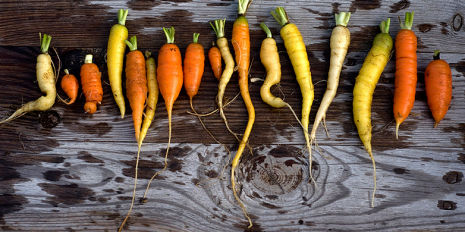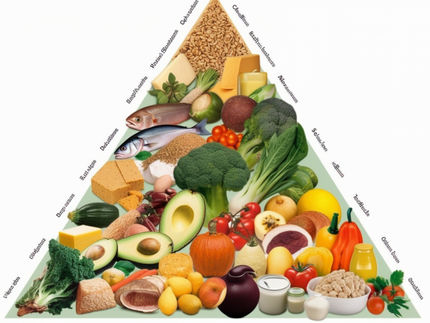More biological diversity in agricultur
Zukunftsblog | ETH Zürich
Advertisement
From the wealth of agricultural biodiversity in Switzerland, only a few old fruit and vegetable types find their way to the major distributors. However, these old crops could help overcome the genetic bottleneck in farming.

Carrots in many shapes and colours. Variety is an insurance against plant diseases
ETH Zürich / Marco Clausen / flicker
Fusarium oxysporum is the name of the fungus endangering the worldwide leader in bananas (the Cavendish) on plantations across the globe. One reason for the rapid spread of this outbreak is the intensive cultivation of genetically identical bananas in monocultures; another reason is the transfer of infection due to the global trade in seedlings. Worldwide-raging pests and diseases are a growing systemic risk for agriculture, and threaten safe food sources.
Erosion of agrobiodiversity
In crop breeding, a general distinction is made between on farm breeding under local or regional environmental conditions and breeding under standardized conditions for example with laboratory approaches and under greenhouse or experimental field conditions. Breeding under standardized conditions trims a plant variety to the highest yield in an environment for cultivation that is as uniform as possible. This high yield is achieved by applying external resources such as fertilizer, pesticide and water. When environmental conditions are hostile or internal and external resources are limited or pests pressure is increasing then productivity falls markedly.
Most of the current commercial crop breeding programmes reduce genetic diversity in agriculture by promoting a few, high-yielding crop varieties that are marketed worldwide. Restrictive intellectual property rights and methods such as hybrid breeding prevent in the economic sector that seeds could be propagated in the field, so farmers are forced to buy new seed every year [1]. If farmers who have previously been engaged in on farm breeding shift to plant material that is not true to type or sterile, then the circulatory system of adaptation is interrupted. The consequence is a dramatic erosion of agrobiodiversity worldwide. [2].
Fallow treasure of old varieties
In “traditional” on farm breeding, those plant individuals are selected during field cultivation that produce the highest yield under local environmental conditions. The seed from these parent plants is then used the following season. In this way, complex varieties evolve that are adapted to local conditions. With this the genetic diversity in the cultivation systems is increased. This makes crops generally more resistant to pests and other environmental factors.
Over thousands of years, an immeasurable wealth of agrobiodiversity has built up like this. There are more than 700 varieties of beans worldwide, and in Switzerland alone (still) some 1000 different varieties of apples. The regional varieties hold enormous genetic diversity, allowing them to adapt swiftly to new environmental factors. They are our insurance against unwanted plant diseases, pests and changing conditions.
This treasure is lying largely unexploited in seed banks and nurseries. Why is that? Let’s take old apple varieties as an example: their lack of resistance to the dreaded fire blight or high susceptibility to scab disease are often an obstacle to broad commercialication, even if these varieties have attractive properties such as late frost tolerance at high altitudes, drought tolerance or an unusual taste.
Modern methods to address deficiencies
If we want to make old varieties more attractive, then new molecular biological techniques of genome editing may have a role to play. Methods such as CrisprCas (see blog) are much more accurate, more efficient and less expensive than conventional breeding procedures, which also makes them interesting for breeders outside the big corporations. If these methods can be successfully integrated into breeding programmes focusing on local adaptation, they could help overcome resistance deficiencies in the old plant varieties.
This works by selectively inactivating a gene that favors a specific disease susceptibility in the old variety, or by taking the resistant gene of a wild plant and reintroducing it to a modern, related variety – for often precisely these characteristics that have been lost by decades of breeding for high performance and yield [3].
In this way, the vast wealth of agrobiodiversity could be transferred from pure conservation breeding in the nurseries to agricultural cultivation for yields.
Easing the genetic bottleneck
To achieve this, more funding for breeding programs is required that will produce locally adapted varieties. Switzerland has taken a first step to promote the regional agricultural biodiversity by launching a national action plan for the sustainable use of plant genetic resources for food and agriculture (NAP-PGREL) [4]. This offers opportunities through new niche markets or in the form of a diversified food system.
Moreover, the shift towards genetically and biologically diverse agriculture may help the new molecular biological methods to gain more acceptance. (Dr. Melanie Paschke, ETH Zürich)
______________
Further information
[1] Kochupillai, Mrinalini (2016). Plant Breeding & Seed Improvement: Then & Now. In: Promoting Sustainable Innovations in Plant Varieties. Springer, Berlin – Heidelberg: 49-77.
[2] Jacobsen S., Sorensen M. & Weiner J. (2013). Feeding the world: genetically modified crops versus agricultural biodiversity. Agronomic Sustainable Development 33: 651-662.
[3]Article in German daily newspaper
[4] Federal Office for Agriculture (1999).





























































